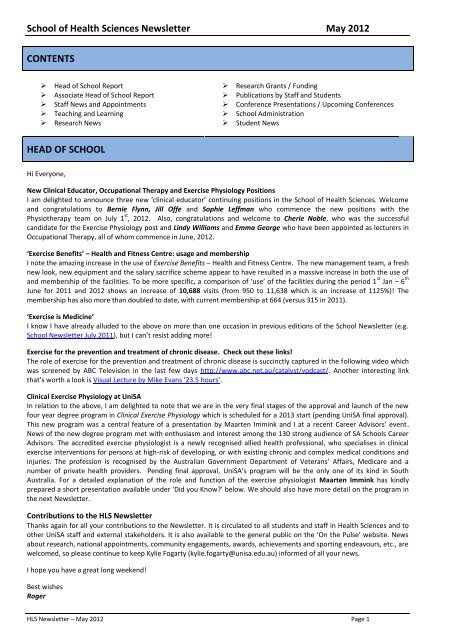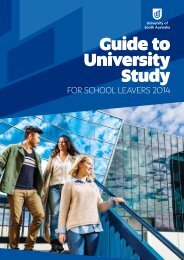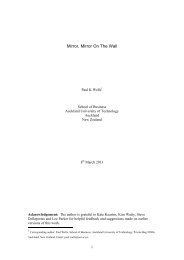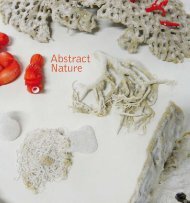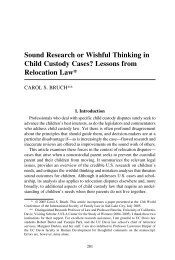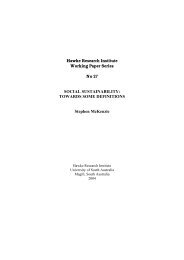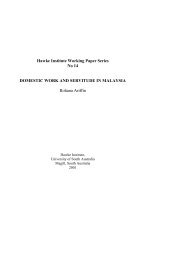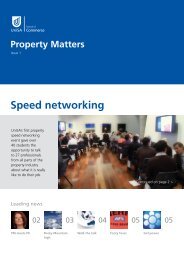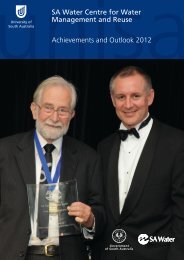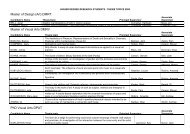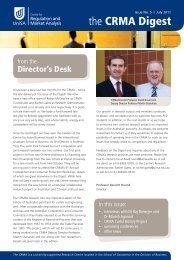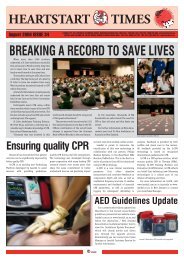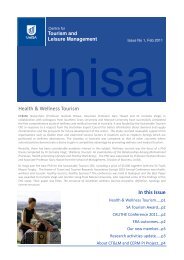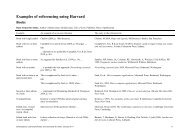Did You Know? - University of South Australia
Did You Know? - University of South Australia
Did You Know? - University of South Australia
You also want an ePaper? Increase the reach of your titles
YUMPU automatically turns print PDFs into web optimized ePapers that Google loves.
School <strong>of</strong> Health Sciences Newsletter May 2012<br />
CONTENTS<br />
� Head <strong>of</strong> School Report<br />
� Associate Head <strong>of</strong> School Report<br />
� Staff News and Appointments<br />
� Teaching and Learning<br />
� Research News<br />
HEAD OF SCHOOL<br />
Hi Everyone,<br />
� Research Grants / Funding<br />
� Publications by Staff and Students<br />
� Conference Presentations / Upcoming Conferences<br />
� School Administration<br />
� Student News<br />
New Clinical Educator, Occupational Therapy and Exercise Physiology Positions<br />
I am delighted to announce three new ‘clinical educator’ continuing positions in the School <strong>of</strong> Health Sciences. Welcome<br />
and congratulations to Bernie Flynn, Jill Offe and Sophie Leffman who commence the new positions with the<br />
Physiotherapy team on July 1 st , 2012. Also, congratulations and welcome to Cherie Noble, who was the successful<br />
candidate for the Exercise Physiology post and Lindy Williams and Emma George who have been appointed as lecturers in<br />
Occupational Therapy, all <strong>of</strong> whom commence in June, 2012.<br />
‘Exercise Benefits’ – Health and Fitness Centre: usage and membership<br />
I note the amazing increase in the use <strong>of</strong> Exercise Benefits – Health and Fitness Centre. The new management team, a fresh<br />
new look, new equipment and the salary sacrifice scheme appear to have resulted in a massive increase in both the use <strong>of</strong><br />
and membership <strong>of</strong> the facilities. To be more specific, a comparison <strong>of</strong> ‘use’ <strong>of</strong> the facilities during the period 1 st Jan – 6 th<br />
June for 2011 and 2012 shows an increase <strong>of</strong> 10,688 visits (from 950 to 11,638 which is an increase <strong>of</strong> 1125%)! The<br />
membership has also more than doubled to date, with current membership at 664 (versus 315 in 2011).<br />
‘Exercise is Medicine’<br />
I know I have already alluded to the above on more than one occasion in previous editions <strong>of</strong> the School Newsletter (e.g.<br />
School Newsletter July 2011), but I can’t resist adding more!<br />
Exercise for the prevention and treatment <strong>of</strong> chronic disease. Check out these links!<br />
The role <strong>of</strong> exercise for the prevention and treatment <strong>of</strong> chronic disease is succinctly captured in the following video which<br />
was screened by ABC Television in the last few days http://www.abc.net.au/catalyst/vodcast/. Another interesting link<br />
that’s worth a look is Visual Lecture by Mike Evans '23.5 hours'.<br />
Clinical Exercise Physiology at UniSA<br />
In relation to the above, I am delighted to note that we are in the very final stages <strong>of</strong> the approval and launch <strong>of</strong> the new<br />
four year degree program in Clinical Exercise Physiology which is scheduled for a 2013 start (pending UniSA final approval).<br />
This new program was a central feature <strong>of</strong> a presentation by Maarten Immink and I at a recent Career Advisors’ event.<br />
News <strong>of</strong> the new degree program met with enthusiasm and interest among the 130 strong audience <strong>of</strong> SA Schools Career<br />
Advisors. The accredited exercise physiologist is a newly recognised allied health pr<strong>of</strong>essional, who specialises in clinical<br />
exercise interventions for persons at high-risk <strong>of</strong> developing, or with existing chronic and complex medical conditions and<br />
injuries. The pr<strong>of</strong>ession is recognised by the <strong>Australia</strong>n Government Department <strong>of</strong> Veterans’ Affairs, Medicare and a<br />
number <strong>of</strong> private health providers. Pending final approval, UniSA’s program will be the only one <strong>of</strong> its kind in <strong>South</strong><br />
<strong>Australia</strong>. For a detailed explanation <strong>of</strong> the role and function <strong>of</strong> the exercise physiologist Maarten Immink has kindly<br />
prepared a short presentation available under ‘<strong>Did</strong> you <strong>Know</strong>?’ below. We should also have more detail on the program in<br />
the next Newsletter.<br />
Contributions to the HLS Newsletter<br />
Thanks again for all your contributions to the Newsletter. It is circulated to all students and staff in Health Sciences and to<br />
other UniSA staff and external stakeholders. It is also available to the general public on the ‘On the Pulse’ website. News<br />
about research, national appointments, community engagements, awards, achievements and sporting endeavours, etc., are<br />
welcomed, so please continue to keep Kylie Fogarty (kylie.fogarty@unisa.edu.au) informed <strong>of</strong> all your news.<br />
I hope you have a great long weekend!<br />
Best wishes<br />
Roger<br />
HLS Newsletter – May 2012 Page 1
School <strong>of</strong> Health Sciences Newsletter May 2012<br />
<strong>Did</strong> <strong>You</strong> <strong>Know</strong>?<br />
..about the new Clinical Exercise Physiology Degree at UniSA?<br />
Dr Maarten Immink (Program Director for Human Movement) explains<br />
PRESENTATION BSc Clinical Exercise Physiology at UniSA Commences 2013<br />
<strong>Did</strong> you know?<br />
Exercise can be used effectively in the treatment <strong>of</strong> the top 10 chronic disease<br />
conditions in <strong>Australia</strong>, although it is prescribed by less than 2% <strong>of</strong> GPs.<br />
HLS Newsletter – May 2012 Page 2
School <strong>of</strong> Health Sciences Newsletter May 2012<br />
ASSOCIATE HEAD OF SCHOOL<br />
As Study Period 2 draws to a close, I would like to thank all staff for their commitment and enthusiasm in their teaching.<br />
Wherever I look, I see individuals and teams who are dedicated to providing a quality teaching experience, and who also<br />
are continually exploring ways to improve the student experience. I believe the culture <strong>of</strong> excellence in teaching and<br />
learning will continue with the re-establishment <strong>of</strong> the school Teaching and Learning Committee (STALC). This committee<br />
will be co-chaired by Sue Gilbert-Hunt and Cristina Blefari. I would like to thank Sue and Cristina for leading this group <strong>of</strong><br />
approximately 20 academics.<br />
I would also like to thank all our academic support staff, who have done a fabulous job in supporting academics, especially<br />
in the face <strong>of</strong> tensions around restructuring <strong>of</strong> their work area arising from the Service Improvement Project (SIP). The<br />
administrative team have also been working hard to scrutinise the SIP data for accuracy, and also to clarify the structure <strong>of</strong><br />
academic support, and the roles, tasks and responsibilities <strong>of</strong> individuals in the academic support team under the new<br />
administrative school structure. The objective in this process is to maintain as much as possible, the current structure and<br />
level <strong>of</strong> support. I have heard many academics express their concern at the possibility <strong>of</strong> the ‘Course Manager’ role for large<br />
courses being dropped. We are hoping, and are confident that this role can be preserved. In Study Period 5, we will be<br />
using the same approach as used in Study Period 2, i.e., that courses with over 150 students will be allocated a ‘Course<br />
Manager’. Course managers will be allocated for the following courses in Study Period 5:<br />
Evidence Based Practice 1 (HLTH 1028)<br />
Sociology <strong>of</strong> Health and Physical Activity (HLTH 2009)<br />
Human Anatomy 101 (HLTH 1030)<br />
Lifespan Growth and Development (HLTH 2020)<br />
Group Dynamics (HLTH 1017)<br />
Tim Brooke-Smith will be in touch with individual course co-ordinators soon to let them know who their Course Manager<br />
will be.<br />
I have provided an outline <strong>of</strong> the support that Course Managers can provide to course coordinators.<br />
Course Manager Role Responsibilities<br />
Course Outline assistance - Modifying previous Course Outline with required changes by the course coordinator and the<br />
school, adjusting timetables/lecture schedules & printing through doc services.<br />
Course home page – Set up discussion board, uploading files such as lecture notes etc.<br />
Assignment support - Set up Assessment and Gradebook, arrange printing (only if required), collate submitted<br />
assignments to distribute to the tutor.<br />
Results Entry - It’s an academics responsibility that the grades are entered accurately Course Managers can assist with<br />
results entry, but the academic must be present through the entering process.<br />
Class lists - If required, class lists can be requested through the Administrative Assistants (receptionist).<br />
Equipment order – Order equipment for practicals etc as required.<br />
Room bookings – arrange as required.<br />
Exam Assistance - Format <strong>of</strong> exams, printing through doc services, in-house test invigilation organisation.<br />
Academics are required to take responsibility to enter their grades accurately. Hopefully ‘Gradebook’, will make this<br />
process easier, but I understand that this platform is new, and with all new systems, what appears to be simple in the first<br />
instance, may not be that easy! Tim Brooke-Smith is planning to run some drop-in sessions in the school, near grade entry<br />
time, to provide academics with some help support with ‘Gradebook’ if required.<br />
I hope most staff can refresh themselves with a break over the mid-semester, and I also wish you a safe and relaxing June<br />
long weekend.<br />
Regards<br />
Kerry<br />
HLS Newsletter – May 2012 Page 3
School <strong>of</strong> Health Sciences Newsletter May 2012<br />
STAFF NEWS AND APPOINTMENTS<br />
Congratulations to Dr Alison Hill on the<br />
arrival <strong>of</strong> her gorgeous little boy Jacob Taylor<br />
born Sunday, 6 May weighing 7lb 15 oz.<br />
Alison is a Lecturer in Nutrition together with<br />
a joint research position in the Nutritional<br />
Physiology Research Centre<br />
Congratulations to Cristina Blefari and her<br />
partner Matthew Sachse who were married last<br />
Saturday, 26 May 2012. Cristina is a Lecturer in<br />
Nuclear Medicine.<br />
� Wendy Barber has been a member <strong>of</strong> the <strong>Australia</strong>n Sonographers Association (ASA) since 2001 and was recently<br />
elected unopposed to the Board <strong>of</strong> Directors. Wendy is hoping that her broad experience across clinical sonography and<br />
education <strong>of</strong> sonographers will add value to the Association, the pr<strong>of</strong>ession and the membership. With a current<br />
membership <strong>of</strong> 3450, the ASA is the peak body and leading voice for <strong>Australia</strong>’s diagnostic medical sonographers.<br />
Wendy will be replacing Maureen Phillips, who commenced on the ASA Board in 2006 and whose contributions included<br />
chairing the Finance Committee and the Sonographer Advancement Working Party. Maureen will continue to advise the<br />
HLS Newsletter – May 2012 Page 4
School <strong>of</strong> Health Sciences Newsletter May 2012<br />
ASA on standards, support and resources to enable tutor sonographers to perform their role at a level which will assist<br />
with the successful transition <strong>of</strong> new entrants into the pr<strong>of</strong>ession.<br />
� Pr<strong>of</strong>essor Roger Eston has been appointed to the Editorial Board <strong>of</strong> the International Journal <strong>of</strong> Sports Physiology and<br />
Performance<br />
� Dr Alison Coates was pr<strong>of</strong>iled in the Healthy Development Adelaide (HAD) Newsletter for the month <strong>of</strong> June -<br />
https://www.adelaide.edu.au/hda/news/newsl/HDA%20Newsletter%20June%202012.pdf<br />
� Congratulations to Dr Rebecca Thomson who was successful in winning a Heart Foundation Travel Grant ($2,000) to<br />
attend the Annual Congress <strong>of</strong> the European College <strong>of</strong> Sport Science in Bruges, Belgium on 4-7 July 2012. The<br />
presentation is titled “The effect <strong>of</strong> acute exercise induced fatigue on the rate <strong>of</strong> increase in heart rate at the onset <strong>of</strong><br />
submaximal cycling”.<br />
HLS Newsletter – May 2012 Page 5
School <strong>of</strong> Health Sciences Newsletter May 2012<br />
TEACHING AND LEARNING<br />
5 TH ABORIGINAL POWER CUP 2012<br />
Supported by the <strong>University</strong> <strong>of</strong> <strong>South</strong> <strong>Australia</strong>, the Aboriginal Power Cup (APC) (run by Power Community Ltd in<br />
collaboration with the Government <strong>of</strong> <strong>South</strong> <strong>Australia</strong> and Santos) is a fun program that mixes sport with learning. It<br />
involves both male and female football teams made up <strong>of</strong> Indigenous students from schools across <strong>South</strong> <strong>Australia</strong>. Over<br />
300 students from 25 schools participated in this year’s event which was held at Alberton Oval from Thursday 17 May to<br />
Saturday 19 May. The program commenced in February and concluded in May with a three-day carnival at Alberton Oval.<br />
To reach the on-field final, teams must attend school, enrol in a 60-hour SACE Unit and form 9-A-Side male and female<br />
football teams. Working in their teams the students must complete a range <strong>of</strong> curriculum tasks including design <strong>of</strong> team<br />
uniforms and team songs, development <strong>of</strong> training schedules, appointment <strong>of</strong> team coaches and mentors, and activities to<br />
assist with goal setting, leadership and career development. All students who meet attendance criteria and the curriculum<br />
expectations travel to Alberton Oval for the three-day carnival.<br />
The carnival includes over 90 games <strong>of</strong> 9-A-Side footy plus a career expo, team breakfast at AAMI Stadium, cultural<br />
activities and educational workshops.<br />
Below are some pictures from the event. .<br />
Roger Eston, Stephen Dowdy, Joanne Wright, Stephen Boyle,<br />
Jillian Miller, Raewyn Todd, Deb Turley, Tim Brooke-Smith and<br />
Catherine Madigan.<br />
HLS Newsletter – May 2012 Page 6
School <strong>of</strong> Health Sciences Newsletter May 2012<br />
HLS Newsletter – May 2012 Page 7
School <strong>of</strong> Health Sciences Newsletter May 2012<br />
ISUOG ULTRASOUND OUTREACH PROJECT: REMOTE AFRICA<br />
I was an international ultrasound trainer volunteer for the Ghana Outreach Project through ISUOG (International Society <strong>of</strong><br />
Ultrasound in Obstetrics and Gynaecology)<br />
The ISUOG ultrasound outreach program delivers intensive hands-on training in regions identified as areas <strong>of</strong> need with a<br />
high maternal mortality rate. The maternal mortality rate in Ghana accounts for around 560 women per 100,000, in<br />
comparison to <strong>Australia</strong> where the maternal death ratio is 8 per 100,000. Introducing ultrasound technology to prenatal<br />
care can help identify pregnancies at risk <strong>of</strong> adverse outcomes and plan deliveries in hospital settings. The training was<br />
conducted in three hospitals -Suntreso, Maternal and Child Health Hospital (MCHH), and Manhyia in Kumasi from 21 - 25<br />
May 2012.<br />
Project partners were Millennium Cities Initiative (MCI) which is a project <strong>of</strong> the Earth Institute at Columbia <strong>University</strong> New<br />
York, Physicians for Peace, and industry partner Siemens.<br />
This was a follow up <strong>of</strong> our visit last year. Last year, trainees were given basic skills in ultrasound. This trip was to give the<br />
trainees advanced ultrasound skills, evaluate their progress and teach them clinical applications in management <strong>of</strong><br />
obstetric and gynaecologic problems.<br />
Participants / trainees were 10 Level II trainees (trained by us last year: 3 Physicians, 6 NMWs, 1 Sonographer), 5 NMWs<br />
trained by the sonographer, 50 midwives for a general ultrasound seminar.<br />
Please visit our blog to read about our amazing experiences. http://isuogoutreach.wordpress.com/<br />
HLS Newsletter – May 2012 Page 8<br />
Dr Nayana Parange<br />
Training team with the Director <strong>of</strong> Kumasi Health Metro<br />
Dr Yeboah Awudzi (in the centre).<br />
From L to R: Dr Nayana Parange (UnISA), Janet<br />
Horenstein (LA, USA), Pr<strong>of</strong> Tony Johnson (Texas, USA ),<br />
Niki Harding (Manchester, UK)
School <strong>of</strong> Health Sciences Newsletter May 2012<br />
Some sights on the way to work<br />
HLS Newsletter – May 2012 Page 9
School <strong>of</strong> Health Sciences Newsletter May 2012<br />
VERT – The Advertiser, Tuesday 22 May 2012<br />
HLS Newsletter – May 2012 Page 10
School <strong>of</strong> Health Sciences Newsletter May 2012<br />
RESEARCH NEWS<br />
� Congratulations to PhD Candidate Louise Wiles on who was recently awarded a payment under the HDR Publication<br />
Incentive Scheme for her publications titled “Sixty-five years <strong>of</strong> ‘Physical Therapy’: bibliometric analysis <strong>of</strong> research<br />
publications from 1945 through 2010” and “Twenty-five years <strong>of</strong> <strong>Australia</strong>n nursing and allied health pr<strong>of</strong>essional<br />
journals: bibliometric analysis from 1985 through 2010”. Louis is supervised by Pr<strong>of</strong>essor Tim Olds and Associate<br />
Pr<strong>of</strong>essor Marie Williams.<br />
� Congratulations to PhD Candidate Lauren Frensham on her successful application for the Maurice de Rohan<br />
International Scholarship. Lauren is supervised by Dr Jim Dollman, Assoc Pr<strong>of</strong> Gaynor Parfitt and Dr Janet Bryan. Lauren<br />
will use the scholarship to visit experts in the USA, specifically Assoc Pr<strong>of</strong> Lee Jones, Duke <strong>University</strong>, North Carolina to<br />
learn more about the latest methods for delivering health promotion to cancer survivors. She will also visit Assoc Pr<strong>of</strong><br />
Catrine Tudor-Locke, Pennington Biomedical Research Centre, Louisiana, to learn the latest advances in physical activity<br />
promotion using pedometers as motivational tools. A great opportunity for Lauren!<br />
RESEARCH GRANTS / FUNDING<br />
2013 ARTHRITIS AUSTRALIA NATIONAL RESEARCH PROGRAM<br />
Application for 2013 Research Grants will open Monday 7 May 2012 and close 5pm Friday 6 July 2012<br />
The objectives <strong>of</strong> the research and pr<strong>of</strong>essional education program are:<br />
� To support specific research projects into arthritis and other musculoskeletal disorders<br />
� To support and foster the career development <strong>of</strong> scientists and clinical investigators committed to research into<br />
arthritis and allied disorders<br />
Project Grants & Grants in Aid<br />
Grants are typically for short-term projects with well-defined aims that can be achieved within a 12 month period. In some<br />
cases these grants address particular questions and may complement larger established programs <strong>of</strong> research. The<br />
amount allocated is generally in the range <strong>of</strong> $10,000 - $15,000 per grant for new investigator grants (defined as within 6<br />
years <strong>of</strong> receiving their PhD). A maximum <strong>of</strong> four project grants valued up to $50,000 will be available, including grants<br />
focusing on specific arthritic conditions such as rheumatoid arthritis.<br />
DEFENCE HEALTH FOUNDATION<br />
The Foundation makes grants annually to medical research projects that will benefit the health and well‐being <strong>of</strong> the<br />
Defence community. The Defence community is defined as serving and ex‐serving ADF personnel, and their immediate<br />
families.<br />
The type <strong>of</strong> medical research funded includes the study <strong>of</strong> the causes, treatment and prevention <strong>of</strong> human diseases. The<br />
term diseases includes physical or mental ailments, disorders, defects, wounds and morbid conditions, whether <strong>of</strong> sudden<br />
onset or gradual development and whether <strong>of</strong> genetic or other origin.<br />
Priority Research Areas -<br />
This year’s funding is aimed at targeting the following areas, but researchers working on projects outside these areas<br />
should not be deterred from applying:<br />
� Mild traumatic brain injury in general, and concussion and impacts relating to blast injuries<br />
� Osteoarthritis, deterioration in muscular strength and other musculo-skeletal conditions<br />
� Trauma resuscitation<br />
� Family impact research that will positively affect the health and wellbeing <strong>of</strong> military and veterans' families, for<br />
example:<br />
HLS Newsletter – May 2012 Page 11
School <strong>of</strong> Health Sciences Newsletter May 2012<br />
Grants Available<br />
� On causes, consequences or health promotion that is designed to prevent disease, including minimising<br />
the incidence and risks <strong>of</strong> obesity, alcohol abuse and mental health disorders.<br />
� Rehabilitation services required for the sufferers <strong>of</strong> physical or mental ill-health, and their families.<br />
Establishment Grants – minimum <strong>of</strong> $25,000 and a maximum <strong>of</strong> $50,000 (12 months).<br />
The aim <strong>of</strong> Foundation Establishment Grants is to assist a new or an established investigator to progress a novel or<br />
innovative area <strong>of</strong> research to the pro<strong>of</strong> <strong>of</strong> principle stage that would render that investigator’s grant proposal competitive<br />
in obtaining other external grant funding the following year. It can be used for any combination <strong>of</strong> personnel, equipment,<br />
consumables or other expenses.<br />
Booster Grants - maximum <strong>of</strong> $100,000 (12 months to 3 years).<br />
The aim <strong>of</strong> Foundation Booster Grants is to assist an established research project expand its scope or duration in order to<br />
pursue new lines <strong>of</strong> investigation or to be able to bring forward the publication <strong>of</strong> results. The grant will be in the form <strong>of</strong> a<br />
renewable annual grant <strong>of</strong> up to three years. The Booster Grant can be used for any combination <strong>of</strong> personnel, equipment,<br />
consumables or other expenses.<br />
Invitations to apply for grants are now open and must be received by 9 August 2012.<br />
PROSTATE CANCER FOUNDATION OF AUSTRALIA<br />
<strong>Australia</strong>n research into prostate cancer (PCa). In the last 5 years, through a competitive peer review process, and clear<br />
funding strategy, the program has awarded more than $30M to 136 projects nationwide <strong>of</strong> which 57 remain active.<br />
Priority Research Areas -<br />
In 2012, PCFA invites applications in its priority areas for funding, specifically, projects seeking to:<br />
� Discover the genetic and cellular factors which initiate and/or perpetuate prostate cancer (PCa)<br />
� Discover, develop and clinically validate new, non-invasive tests to detect PCa, and/or to determine whether a<br />
patient's cancer is surgically curable<br />
� Discover, develop and clinically validate new biomarkers that predict the future clinical course <strong>of</strong> PCa and/or the<br />
response to future chemotherapy<br />
� Discover, and validate through preclinical and clinical trials, novel molecular targets for chemotherapy <strong>of</strong> locallyinvasive<br />
or metastatic PCa, including androgen-independent cancers<br />
� Develop new treatment strategies for PCa, especially locally-invasive or metastatic cancers<br />
� Undertake research, which if successful, will provide immediate improvements in the quality <strong>of</strong> life <strong>of</strong> patients<br />
with PCa, especially those with advanced PCa, including studies <strong>of</strong> the families and carers <strong>of</strong> men affected by<br />
prostate cancer, and studies <strong>of</strong> the psychological burden <strong>of</strong> prostate cancer to those men, their families and their<br />
caregivers.<br />
Grants Available<br />
Movember <strong>You</strong>ng Investigator grants <strong>of</strong> up to $150,000 per annum for up to four years are aimed at supporting the<br />
brightest young investigators to undertake research into prostate cancer and to support those investigators as they mature<br />
toward independent scientists.<br />
Movember New Concept Grants <strong>of</strong> up to $150,000 per annum for up to two years are aimed at funding cutting edge,<br />
innovative ideas brought forward by both, senior researchers currently working in the prostate cancer field and senior<br />
scientists working in other areas <strong>of</strong> cancer research. The aim <strong>of</strong> the Movember New Concept Grant category is to fund high<br />
risk, high return, innovative ideas, that have the potential to generate new research directions in prostate cancer.<br />
Movember Equipment Grants <strong>of</strong> up to $100,000 are aimed at supporting purchases <strong>of</strong> large pieces <strong>of</strong> equipment that can<br />
be shared amongst more than one group <strong>of</strong> researchers and enable them to conduct competitive medical research<br />
Invitations to apply for grants are now open and must be received by 6 July 2012.<br />
HLS Newsletter – May 2012 Page 12
School <strong>of</strong> Health Sciences Newsletter May 2012<br />
SIR ROBERT MENZIES MEMORIAL RESEARCH SCHOLARSHIP IN THE ALLIED HEALTH SCIENCES<br />
The Sir Robert Menzies Memorial Foundation invites applications for its research scholarship in the allied health sciences.<br />
This supports postgraduate students to conduct full-time research in one <strong>of</strong> the allied health sciences. Graduates in the<br />
disciplines <strong>of</strong> clinical psychology, nutrition, nursing, occupational therapy, physiotherapy and speech pathology are<br />
encouraged to apply, although applications from graduates <strong>of</strong> other allied health disciplines will also be accepted. The<br />
award is for up to two years at an <strong>Australia</strong>n tertiary institution with appropriate facilities for postgraduate research. The<br />
scholarship will be open to full-time students in a research PhD programme which is likely to be completed during the two<br />
year tenure <strong>of</strong> the scholarship. Applicants must be <strong>Australia</strong>n citizens <strong>of</strong> at least five years’ standing. The level <strong>of</strong><br />
remuneration will be $27,500 per year, and one or more scholarships are available<br />
Invitations to apply for grants are now open and must be received by 30 June 2012.<br />
For further information regarding the above opportunities please contact the Senior Business Development Manager Bruce<br />
Chadwick.<br />
HEALTH WORKFORCE INSIGHTS<br />
Please find below a link to a HWA Newsletter that has funding opportunities in the areas <strong>of</strong> Supervision Fellowships and<br />
Workforce Research.<br />
http://www.healthworkforceaustralia.com.au/hwinsights/issue1/index.html#clinicalsupervision<br />
PUBLICATIONS BY STAFF AND STUDENTS<br />
1. Batchelor FA, Hill KD, Mackintosh SF, Said CM, Whitehead CH: A multi-factorial falls prevention program in people with<br />
stroke returning home after rehabilitation: a randomized, controlled trial. Archives <strong>of</strong> Physical Medicine and<br />
Rehabilitation.<br />
2 Year IF= 2.254, 5 Year IF= 2.731 (ERA A)<br />
Abstract<br />
2. Burton, R., Olds, T., Stewart, A. & Daniell, N. (2012). A negative relationship between leg length on leg cross-sectional<br />
areas in adults. American Journal <strong>of</strong> Human Biology, published online 12 March 2012 DOI: 10.1002/ajhb.22258.<br />
1 Year IF= 2.021, 5 Year IF= 2.347 (28/86 Biology)<br />
Abstract<br />
3. Chan, W., Immink, M.A. & Hillier, S. (2012). Yoga and exercise for symptoms <strong>of</strong> depression and anxiety in people with<br />
post-stroke disability: A pilot randomised controlled trial. Alternative Therapies in Health and Medicine, 18(3): 34-43.<br />
ISI JCR: Integrative & Complementary Medicine<br />
5 Year IF= 1.75 (7/21 Integrative & Complementary Medicine)<br />
Abstract Not Available<br />
4. Daniell, N., Olds, T. & Tomkinson, G. (2012). Criterion validity <strong>of</strong> whole body surface area equations: a comparison<br />
using 3D laser scanning. American Journal <strong>of</strong> Physical Anthropology, 148 (1): 148-155.<br />
1 Year IF= 2.693, 5 Year IF= 3.013 (21/45 Evolutionary Biology)<br />
Abstract<br />
5. English C, Thoirs K, Coates A, Ryan A, Bernhardt J. Changes in fat mass in stroke survivors. A systematic review.<br />
International Journal <strong>of</strong> Stroke March 2012 DOI: 10.1111/j.1747-4949.2012.00824.x<br />
Impact Factor Not Provided<br />
Abstract<br />
HLS Newsletter – May 2012 Page 13
School <strong>of</strong> Health Sciences Newsletter May 2012<br />
6. Eston, R. (2012) Use <strong>of</strong> Ratings <strong>of</strong> Perceived Exertion (RPE) in Sports. (Invited Commentary) International Journal <strong>of</strong><br />
Sports Physiology and Performance. 7, 175-182<br />
1 Year IF = 0.787, 5 Year IF 1.093 (Ranking 49/80 Sports Sciences)<br />
Abstract<br />
7. Foley, L., Maddison, R., Olds, T., & Ridley, K. (2012). Self-report use-<strong>of</strong>-time tools for the assessment <strong>of</strong> physical activity<br />
and sedentary behaviour in children: Review. Obesity Reviews, published online 20 March 2012 DOI: 10.1111/j.1467-<br />
789X.2012.00993.x.<br />
1 Year IF= 5.862, 5 Year IF=7.088 (14/116 Endocrinology & Metabolism)<br />
Abstract<br />
8. Loudon A, Barnett T, Piller N, Immink MA, Visentin D, Williams AD. The effect <strong>of</strong> yoga on women with secondary arm<br />
lymphoedema from breast cancer treatment.<br />
5 Year IF=20195 (15/21 Integrative & Complementary Medicine)<br />
Abstract<br />
9. Matricciani, L., Olds, T., Blunden, S., Rigney, G. & Williams, M (2012). Never enough sleep: a brief history <strong>of</strong> sleep<br />
recommendations for children. Pediatrics, 129 (3): 548-556.<br />
1 Year IF=5.391, 5 Year IF=5.850 (1/109 Pediatrics)<br />
Abstract<br />
10. Minshull, C., Eston, R., Rees, D. and Gleeson, N. (2012) Knee joint neuromuscular activation performance during muscle<br />
damage and superimposed fatigue. Journal <strong>of</strong> Sports Sciences. Published on line ahead <strong>of</strong> print<br />
1 year IF = 1.870, 5yr IF = 2.572 (19/80 Sports Sciences)<br />
Abstract<br />
11. Olds, T., Ferrar, K., Gomersall, S., Walters, J. & Maher, C. (2012). The elasticity <strong>of</strong> time – associations between physical<br />
activity and use <strong>of</strong> time in adolescents. Health Education & Behavior, published online 29 March 2012.<br />
Impact Factor not listed on the Web <strong>of</strong> Science<br />
Abstract<br />
12. Stankov, I., Olds, T., & Cargo M (2012). Overweight and obese adolescents: What turns them <strong>of</strong>f physical activity?<br />
International Journal <strong>of</strong> Behavioral Nutrition and Physical Activity, 9(1):53.<br />
1 Year IF=3.169, 5 Year IF= Not listed (18/70 Nutrition and Dietetics)<br />
Abstract<br />
13. Stanley, R., Ridley, K. & Dollman, J. (2012). Correlates <strong>of</strong> children’s time-specific physical activity: a review <strong>of</strong> the<br />
literature, International Journal <strong>of</strong> Behavioral Nutrition and Physical Activity. 9(1):53.<br />
1 Year IF=3.169 , 5 Year IF= Not listed (18/70 Nutrition and Dietetics)<br />
Abstract<br />
14. Wiles, L., Williams, M. & Olds, T. (2012). Twenty-five years <strong>of</strong> <strong>Australia</strong>n nursing and allied health pr<strong>of</strong>essional journals:<br />
bibliometric analysis from 1985 through 2010, Scientometrics, published online 28 March 2012 DOI: 10.1007/s11192-<br />
012-0704-y.<br />
1 Year IF=1.905, 5 Year IF= 2.415 (23/97 Computer Science-Interdisciplinary Applications)<br />
Abstract<br />
15. Williams, M., Olds, T., Petkov, J., Cafarella, P. & Frith, P. (2012). A reduction in the use <strong>of</strong> volunteered descriptors <strong>of</strong> air<br />
hunger is associated with increased walking distance in people with COPD. Respiratory Care, published online 17 Feb<br />
2012.<br />
1 Year IF=1.534, 5 Year IF=not listed (34/46 Respiratory System)<br />
Abstract<br />
16. Zhang, S., Murray, P., Zilmer, R., Eston, R.G., Catt, M. and Rowlands, A.V. Activity classification using the GENEA:<br />
Optimum sampling frequency & number <strong>of</strong> axes. Medicine and Science in Sports and Exercise. DOI:<br />
10.1249/MSS.0b013e31825e19fd.<br />
1 Year IF = 4.106, 5 Year IF = 4.748 (3/80 Sports Sciences)<br />
Abstract<br />
HLS Newsletter – May 2012 Page 14
School <strong>of</strong> Health Sciences Newsletter May 2012<br />
SYDNEY MORNING HERALD - LIFE AND STYLE<br />
Article <strong>of</strong> interest – Dr Maarten Immink<br />
http://www.smh.com.au/lifestyle/life/live-longer-be-a-log-heres-how-20120510-1yeza.html<br />
PRE-EXERCISE SCREENING: Guide to the <strong>Australia</strong>n adult pre-exercise screening system by Pr<strong>of</strong>essor Kevin Norton and<br />
Dr Linda Norton<br />
The above titled textbook, published jointly by ESSA, Fitness <strong>Australia</strong> and Sports Medicine <strong>Australia</strong> is available in full and<br />
for free at the following link.<br />
http://fitness.org.au/visageimages/pre_exercise_screening_textbook_2012.pdf<br />
CONFERENCE PRESENTATIONS / UPCOMING CONFERENCES<br />
� Dr Maarten Immink was interviewed by ABC 891 Adelaide (Adelaide), Sonya Feldh<strong>of</strong>f and Peter Goers on Tuesday, 18<br />
May 2012.<br />
Interview with Dr Maarten Immink, Program Director <strong>of</strong> Human Movement and Clinical Exercise Science at the<br />
<strong>University</strong> <strong>of</strong> SA, about the benefits <strong>of</strong> meditation. Immink says “meditation is time tested, and modern scientific<br />
techniques can measure how it beneficially influences function and health”. He discusses the field <strong>of</strong> Clinical Exercise<br />
Science. He says “anyone with a chronic condition like hypertension and diabetes can get referred through Medicare or<br />
privately to seek advice from an exercise physiologist”. Immink says “meditation participation rates are higher than<br />
those that play AFL football”. He discusses the barriers towards entry for meditation. He discusses how to meditate. He<br />
encourages people to look him up on the <strong>University</strong> <strong>of</strong> SA website if they want more information.<br />
� Dr Alison Coates was interviewed on Radio 5AA on the benefits <strong>of</strong> cocoa polyphenols, Wednesday 6 June 2012.<br />
5AA (Adelaide)<br />
Breakfast - 6/06/2012 7:09 AM<br />
Keith Conlon and John Kenneally<br />
Conlon says that during National Science and Health Research, there is the idea that if people ate some dark chocolate<br />
every day for ten years, it might save a lot <strong>of</strong> lives and other non-fatal heart attacks. Conlon and Kenneally are joined by<br />
Dr Alison Coates, Nutritional Researcher, <strong>University</strong> <strong>of</strong> <strong>South</strong> <strong>Australia</strong> to discuss this proposal. Coates says “that cocoa<br />
polyphenols, the bioactive components in cocoa are getting some positive press. She points out however that<br />
promoting the consumption <strong>of</strong> dark chocolate every day could be easily turned around by people who think that eating<br />
chocolate is good for them, which needs to be kept in check”. Coates says “that there is very good evidence to show<br />
that cocoa polyphenols help lower cholesterol and control blood pressure that in the long term would help reduce the<br />
risk <strong>of</strong> heart disease and non-fatal strokes”. She points out “that there is a lot <strong>of</strong> sugar and saturated fat that is the bad<br />
side to chocolate”.<br />
� Margarita Tsiros was an invited speaker at the <strong>South</strong> <strong>Australia</strong>n Podiatry Conference, Adelaide Convention Centre, 2 nd –<br />
4 th May 2012. The title <strong>of</strong> her presentation was ‘Clinical considerations in delayed onset walking: Identifying the window<br />
<strong>of</strong> opportunity”.<br />
� Pr<strong>of</strong>essor Tim Olds was an Invited Plenary Speaker at the Contech 2012: Confectionery and Food Industry Technical<br />
Conference in Melbourne, 29-30 May, and a Keynote Speaker at the ACHPER State Physical Education Conference SA.<br />
Adelaide, 19-20 April.<br />
� Katia Ferrar, Sjaan Gomersall, Carol Maher and Rebecca Stanley attended the International Society <strong>of</strong> Behavioral<br />
Nutrition and Physical Activity Annual Meeting conference held in Austin, Texas (23-26th May 2012). Rebecca Stanley<br />
presented her paper "Intra-individual consistency <strong>of</strong> physical activity at different periods <strong>of</strong> the school day: implications<br />
for measurement" and Katia and Rebecca presented a poster titled "Across the ditch: a comparison <strong>of</strong> how <strong>Australia</strong>n<br />
and New Zealand youth use their time".<br />
HLS Newsletter – May 2012 Page 15
School <strong>of</strong> Health Sciences Newsletter May 2012<br />
� Rebecca Thomson presented at the <strong>South</strong> <strong>Australia</strong>n Cardiovascular Research Forum on 4 May in Adelaide. The<br />
presentation was titled “The rate <strong>of</strong> increase in heart rate at the onset <strong>of</strong> submaximal cycling tracks fatigue-induced<br />
changes in exercise performance”.<br />
� Pr<strong>of</strong>essor Lorimer Moseley was a keynote speaker at the French Physiotherapy Congress in Paris, 4-6 May 2012.<br />
Presentation Title: “The brain’s maps <strong>of</strong> body and space – a role in chronic pain”?<br />
� Pr<strong>of</strong>essor Lorimer Moseley was a keynote speaker at the International Symposium on Complex Regional Pain Syndrome<br />
held in Leiden, Netherlands, 10-11 May. Presentation Titles: “Predicting and preventing CRPS: are we any closer”? And<br />
“Graded motor imagery for chronic CRPS”.<br />
� Pr<strong>of</strong>essor Lorimer Moseley was a keynote speaker at the Pain & Physiotherapy Symposium held in Madrid, Spain, 12-13<br />
May. Presentation Title: “Pain and the brain”.<br />
� Pr<strong>of</strong>essor Lorimer Moseley gave invited lectures at the <strong>University</strong> <strong>of</strong> Leuven, Belgium and King's College London, UK.<br />
� Pr<strong>of</strong>essor Lorimer Moseley was a keynote speaker at the 31st Annual Scientific Meeting <strong>of</strong> the American Pain Society in<br />
Honolulu, Hawaii, 16-19 May. Presentation Title: “The body in mind - disruption and treatment <strong>of</strong> cortical body maps in<br />
people with chronic pain”.<br />
� Parfitt G, Evans H and Eston R. Perceptually regulated training at RPE13 is pleasant and improves physical health. <strong>South</strong><br />
<strong>Australia</strong>n Cardiovascular Research Forum, Adelaide, May 2012.<br />
� Eston, R., Evans H, Faulkner J, Lambrick D, Al-Rahamneh H and Parfitt G. A perceptually-regulated, graded exercise test<br />
predicts peak oxygen uptake during treadmill exercise in active and sedentary participants. <strong>South</strong> <strong>Australia</strong>n<br />
Cardiovascular Research Forum, Adelaide, May 2012.<br />
� Zwar N, Middleton S, Reddel H, Bunker J, Crockett A, Dennis S, van Schayck CP, Liaw T, Vagholkar S, Hermiz O, Hasan<br />
I. The PELICAN study: Progress <strong>of</strong> a trial <strong>of</strong> early intervention for Chronic Obstructive Pulmonary Disease by practice<br />
nurse and GP teams. Plenary Presentation. <strong>Australia</strong>n Practice Nurses Association Annual Conference 2011. Sydney 7th -<br />
9th April 2011.<br />
� Zwar NA, Middleton S, Reddel HK, van Schayck CP, Crockett A, Dennis S, Marks G, Bunker J, Vagholkar S, Liaw T. Hasan I,<br />
Hermiz O. Primary care EarLy Intervention for Copd mANagement (PELICAN) study: progress on a cluster randomised<br />
trial. Oral presentation. 6th World Conference <strong>of</strong> the International Primary Care Respiratory Group. Edinburgh 25th-<br />
28th April 2012.<br />
CALL FOR ABSTRACTS FOR THE EMERGING HEALTH POLICY RESEARCH CONFERENCE.<br />
Wednesday, 15 August 2012 – <strong>University</strong> <strong>of</strong> Sydney<br />
<strong>You</strong> are invited to submit an abstract for the Emerging Health Policy Research Conference which is being held on<br />
Wednesday 15 th August 2012.<br />
Attached is the template to be used for the abstract, which must then be submitted by 25 th June 2012.<br />
Please refer to the website below for more information.<br />
http://www.menzieshealthpolicy.edu.au/other_tops/other%20tops/ehprcallforabstracts2012.pdf<br />
2012 INTERNATIONAL CONFERENCE ON APPLIED STRENGHT AND CONDITIONING<br />
9 – 11 November 2012 – Surfers Paradise, Gold Coast<br />
Please refer to the website below for more information.<br />
http://www.strengthandconditioning.org/index.php?option=com_content&view=article&id=100:2012-internationalconference-on-applied-strength-and-conditioning&catid=84:conferences&Itemid=475<br />
HLS Newsletter – May 2012 Page 16
School <strong>of</strong> Health Sciences Newsletter May 2012<br />
INDIGENOUS ALLIED HEALTH CONFERENCE<br />
22 – 24 November 2012 – Bardon Centre, Brisbane<br />
Please refer to the website below for more information.<br />
http://www.indigenousalliedhealth.com.au/news/index.cfm?loadref=48<br />
SCHOOL ADMINISTRATION<br />
PAYMENT SUMMARIES - POSTAL ADDRESS CHECK<br />
Payroll Services will be sending Payment Summaries (for taxation purposes) to all employees’ postal addresses in the<br />
second week <strong>of</strong> July.<br />
To ensure your Payment Summary is forwarded to the correct address, please check it is correctly recorded in the Human<br />
Resources Information System. To access your details please logon to myUniSA and select the myDetails tab.<br />
If you have any queries relating to Payment Summaries, please email Payroll Services or contact the Payroll Help Line –<br />
extension 22911.<br />
Ruth Blenkiron<br />
Director: Human Resources<br />
Human Resources (HRM)<br />
Chancellery (CHY)<br />
NOMINATIONS NOW OPEN FOR THE 2012 COMMUNITY ACHIEVEMENT AWARD<br />
http://www.awardsaustralia.com/CAA_sa.php<br />
STUDENT NEWS<br />
REFLECTIVE REPORT – PHD CANDIDATE REBECCA STANLEY<br />
The Annual Meeting <strong>of</strong> the International Society <strong>of</strong> Behavioural Nutrition and Physical Activity is one <strong>of</strong> the few<br />
international conferences that amalgamates leading researchers in the fields <strong>of</strong> physical activity and behavioural nutrition.<br />
With the assistance <strong>of</strong> the School <strong>of</strong> Health Sciences travel grant, I was fortunate enough to attend and present at this<br />
year’s conference held in Austin, Texas during May. I presented the findings from a small study in my PhD, which looked at<br />
the intra-individual consistency <strong>of</strong> time-specific physical activity and the implications this has on measuring typical physical<br />
activity behaviour in children, as well as some work I have been doing in collaboration with the National Institute for Health<br />
Innovation at the <strong>University</strong> <strong>of</strong> Auckland, New Zealand, exploring and comparing the time use patterns <strong>of</strong> <strong>Australia</strong>n and<br />
New Zealand children.<br />
In addition to being able to present my research, I attended a number <strong>of</strong> plenary talks and oral presentations. A few<br />
presentations which I found particularly inspiring and generated some thought provoking concepts related to genetic<br />
influences on health behaviour, social networking and technology interventions and more specific to my area <strong>of</strong> interest,<br />
the use <strong>of</strong> GPS, accelerometry and GIS to explore physical activity hotspots in the schoolyard. This new knowledge has<br />
challenged my thinking about where this research field is heading and sparked new ideas for my own research.<br />
HLS Newsletter – May 2012 Page 17
School <strong>of</strong> Health Sciences Newsletter May 2012<br />
Attending this year’s conference has afforded me the opportunity to form important links and networks with other national<br />
and international researchers in my area <strong>of</strong> physical activity research. I was able to attend an early career mentoring lunch<br />
with Pr<strong>of</strong>essor Stuart Biddle from Loughborough <strong>University</strong>. This was a valuable experience and gave me the opportunity to<br />
discuss and gain advice on strategic career plans. As I am nearing the completion <strong>of</strong> my PhD, I also had the opportunity to<br />
discuss potential research opportunities and future collaborative projects with researchers from other universities and<br />
organisations, including the <strong>University</strong> <strong>of</strong> Auckland, <strong>University</strong> <strong>of</strong> Leeds, <strong>University</strong> <strong>of</strong> Queensland and CSIRO.<br />
Overall, attending this conference was a wonderful experience because it not only gave me an opportunity to disseminate<br />
my research and represent the <strong>University</strong> <strong>of</strong> <strong>South</strong> <strong>Australia</strong> at an international conference <strong>of</strong> health researchers but it also<br />
allowed me to meet numerous researchers who I frequently reference in my own work. If I was to pass on a piece <strong>of</strong> advice<br />
to other researchers or students wanting a research career, I would highly recommend attending international conferences<br />
as this is one avenue where innovative and inspiring research can be generated and future careers can be launched.<br />
HLS Newsletter – May 2012 Page 18


